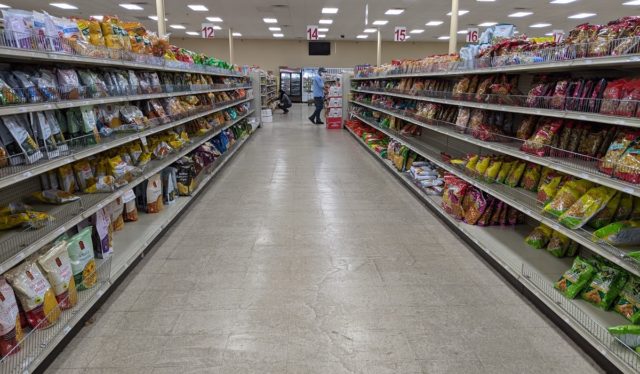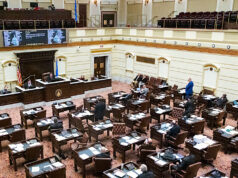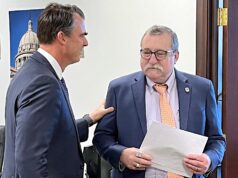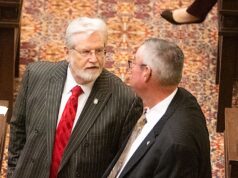
At the end of this year’s regular session of the Oklahoma Legislature, Gov. Kevin Stitt called for a special session to provide Oklahomans “inflation relief.” The governor’s preferred mechanisms for providing this relief include eliminating the state’s portion of the sales tax on groceries and a reduction of the state income tax rate by 0.25 percent.
The special session came and went without full legislative action on Stitt’s proposals. The House advanced (again) a variety of tax cut proposals, but Senate President Pro Tempore Greg Treat announced his caucus wanted more time to study the topic. On June 15, Treat appointed the membership of his tax reform working group that will look at proposals and have “a serious, mature conversation about tax reform, conducted in a thoughtful way,”
So it seems like a good time to offer a primer on inflation — one that hopefully policymakers at the State Capitol will understand and consider when deciding what type of relief would best help Oklahomans deal with inflation that reached 8.6 percent in May, surprising many policymakers and economists.
Inflation and where it comes from
The first step in treating a condition is appropriately diagnosing it. So, what exactly is inflation? Inflation is often described as a general increase in the prices of goods over time. However, it is more accurate to call it a loss of purchasing power. One dollar will not buy the same amount of goods or services in 2022 as it would in 1982. This describes inflation — the reduction in purchasing power of a currency over time.
What causes inflation? The Nobel Prize-winning economist Milton Friedman said, “Inflation is always and everywhere a monetary phenomenon.” In other words, inflation occurs when the amount of cash circulating within the economy exceeds the value of goods and services produced. This explains why it is important to understand inflation as a loss of purchasing power and not merely a rise in prices. A variety of factors can cause the prices of some goods to increase over a relatively short time frame. These would include supply chain disruptions, greater difficulty in acquiring the resources needed to create the good and the inability to hire the labor needed to produce the goods. While these circumstances can drive up the prices of affected goods and services, they rarely create the general reduction in purchasing power over sustained periods of time that is associated with inflation. (For more details, the late monetary economist Steve Horwitz made this short video explaining the cause of inflation).
If inflation is the result of too much cash circulating in the economy versus the value of the goods and services, how do we get it under control? In general, there are only a couple of ways to reduce inflation — and neither occurs very quickly. First, we can reduce the amount of cash circulating in the economy. As the institution tasked with managing the nation’s monetary policy, the Federal Reserve can accomplish this by selling government bonds, by increasing the interest rates (the discount rate) it charges banks that borrow money from it, or by increasing the percentage of deposits it requires banks to keep on hand (the reserve ratio). These all have the ability to restrict the cash flowing throughout the economy, although it takes time for their impact to take effect.
Another, less discussed policy option is to take actions to increase the amount of goods and services available. This would entail eliminating the barriers to production and supply. Two good examples of this would be the housing and baby formula markets. Both have seen higher prices and reduced supply. Both are burdened by regulatory environments that prevent increased supply (such as zoning laws for housing and government-granted monopolies for baby formula), which forces prices upward. The solution to these issues, as with most other goods and services for which supply does not meet demand, is to make production of them easier. Reduce the barriers to production and suppliers will provide more of the goods or services in question.
This brings us to Stitt’s grocery tax proposal. If inflation is a result of too much cash flowing in the economy in comparison to the value of goods and services produced, then cutting taxes will not reduce inflationary burdens. Rather, it will increase them. Unless you believe that the low savings rate among Americans will increase as a result of having extra cash, tax cuts will only add fuel to the fire. To think about Oklahoma in particular, such action would come at a time when our region of the country is enduring higher levels of inflation than the national average.
The facts are simple, if politically inconvenient: There is not a lot that a single state can do to combat inflation effectively. The best tools are those that would reduce barriers to production. However, such measures will kick in gradually, not rapidly. They will also have only modest impact as so many factors relating to production of goods and services in an international economy lie outside the reach of a state legislature.
The tax question
Before going further, let me be fully transparent about two things. First, I support eliminating the state portion of sales tax on groceries. In general, sales taxes are regressive, meaning they disproportionately affect those at lower income levels. In addition, the poor also spend a larger share of their overall income on food than do middle and upper class households. For these reasons, eliminating the state’s sales tax on groceries is good public policy, and the idea has bipartisan support in the Legislature.
Second, I also support completely eliminating the state’s income tax. Income taxes distort labor markets. While economists do not all agree on the extent of this distortion, income taxes will impact a portion of workers’ decisions on whether to work, to increase their labor or not to work. Even though low-income households generally receive the income taxes they paid back (and often more through programs such as the earned income tax credit), they lose that portion of their income for the year. There are better ways to collect needed governmental revenues than the income tax, and it is time our policymakers begin exploring those.
With those two admissions out of the way, let’s get back to examining various policy approaches to inflation.
If eliminating the state sales tax on groceries is good policy, should lawmakers do it even if it will exacerbate inflation? That’s a good question for which there may not be a right or wrong answer. It’s rare that you have a policy proposal that has bipartisan support. Generally, it is smart to take advantage of such opportunities while they exist. So which causes the greater harm: the lost opportunity of enacting good public policy or additional short-term inflationary pressure? How policymakers evaluate and answer that question should guide their decision-making.
What about the reduction of the state’s income tax? This proposal is less complicated. It will not result in any measurable benefit that exceeds the cost of the inflationary pressure it creates. The economic gains, especially to those at the lower income levels, will not be enough to justify such a move. Rather than reducing an already low income tax rate, policymakers would be better off evaluating the idea of eliminating the income tax altogether and restructuring the tax code so as to acquire the necessary revenues from other sources.
Inflation hurts. It makes us all poorer. It is created by having too much money in the economy. This places a great deal of pressure on policymakers who want to be viewed as understanding the struggles of citizens and demonstrating their ability to alleviate financial suffering. Unfortunately, passing tax cuts at this time would be like giving a drowning person a glass of water.





















